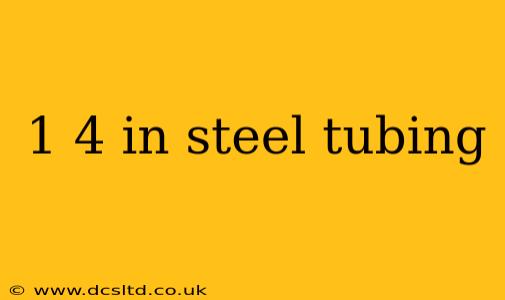Steel tubing, specifically 1 1/4 inch steel tubing, finds extensive use across diverse industries and applications. Understanding its properties, applications, and selection criteria is crucial for anyone working with this material. This guide delves into the specifics of 1 1/4 inch steel tubing, covering key aspects to aid in informed decision-making.
What are the Different Types of 1 1/4 Inch Steel Tubing?
The term "1 1/4 inch steel tubing" is quite broad. Several factors differentiate the types available:
-
Schedule: This refers to the wall thickness. Heavier schedules (like Schedule 40, 80, or 160) indicate thicker walls and greater strength and pressure resistance. Lighter schedules mean thinner walls and are suitable for applications where weight is a concern. You'll often see this specified as "1 1/4 inch Schedule 40 steel pipe," for instance. The schedule number directly relates to the pipe's pressure rating.
-
Material Grade: Steel tubing comes in various grades, each possessing different mechanical properties like tensile strength, yield strength, and ductility. Common grades include ASTM A53 (for general purpose), ASTM A106 (for high-temperature service), and others tailored for specific applications. The grade significantly impacts the tubing's suitability for a given project.
-
Seamless vs. Welded: Seamless tubing is formed from a single piece of steel without welds, providing superior strength and pressure resistance. Welded tubing is created by joining two pieces of steel, offering a more cost-effective option for applications with less demanding requirements. The manufacturing process influences the overall integrity and cost.
-
Finish: Steel tubing may have various surface finishes, including black (mill finish), galvanized (zinc-coated for corrosion resistance), or painted. The choice of finish depends on the intended application and environmental factors.
What is 1 1/4 Inch Steel Tubing Used For?
The applications of 1 1/4 inch steel tubing are incredibly diverse, spanning numerous sectors:
-
Construction: Used in structural framing, handrails, and support structures. The strength and durability of steel make it ideal for these load-bearing applications.
-
Manufacturing: Forms part of machinery components, piping systems, and various industrial equipment. Precision is often key in manufacturing applications.
-
Automotive: Employed in chassis components, exhaust systems, and other structural elements in vehicles. The ability to withstand vibration and stress is crucial here.
-
Oil and Gas: Used extensively in pipelines and other components within the oil and gas industry. Resistance to high pressures and temperatures is vital.
What is the Difference Between Steel Pipe and Steel Tubing?
While the terms are sometimes used interchangeably, there are key distinctions:
-
Dimensional Standards: Steel pipe typically adheres to stricter dimensional standards (like those defined by ANSI), while steel tubing offers more flexibility in dimensions.
-
Manufacturing Processes: While both can be seamless or welded, the manufacturing processes can differ slightly. These differences can impact mechanical properties.
-
Applications: Steel pipe is often associated with conveying fluids (liquids or gases), while steel tubing is more versatile and used in a wider array of applications.
How Much Does 1 1/4 Inch Steel Tubing Weigh?
The weight of 1 1/4 inch steel tubing varies significantly based on the schedule and material grade. Thicker-walled tubing (higher schedules) naturally weighs more. Consult a steel tubing supplier's catalog or online resources to find the specific weight for the desired tubing type.
Where Can I Buy 1 1/4 Inch Steel Tubing?
1 1/4 inch steel tubing is readily available from various sources:
-
Local Steel Suppliers: These offer a wide selection, often with the possibility of custom cutting and other value-added services.
-
Online Retailers: Many online retailers offer steel tubing, providing convenience and often competitive pricing.
-
Specialty Metal Suppliers: For specialized grades or finishes, consider contacting specialty metal suppliers.
This guide provides a comprehensive overview of 1 1/4 inch steel tubing. Remember to always consult with professionals and relevant standards when specifying and using this material in your projects to ensure safety and compliance. The information provided here is for general guidance only and should not be considered professional engineering advice.
